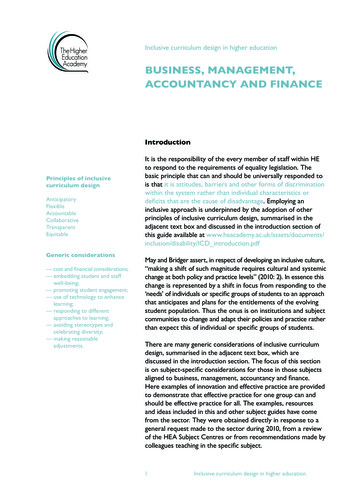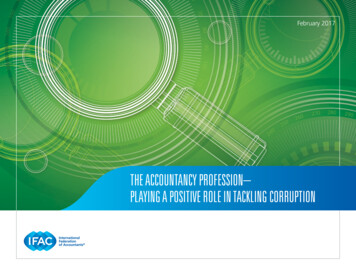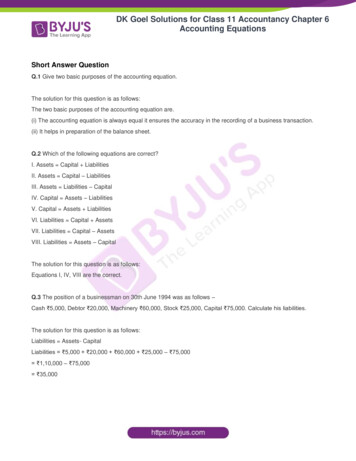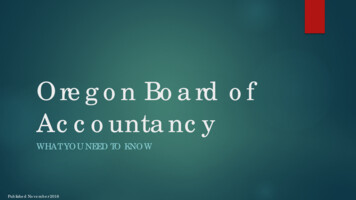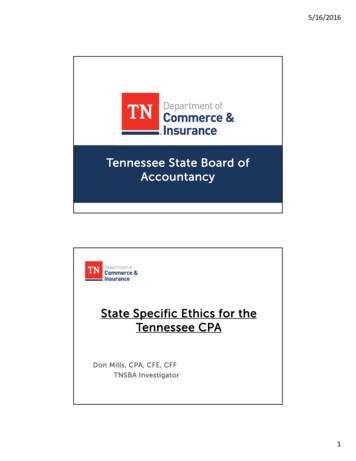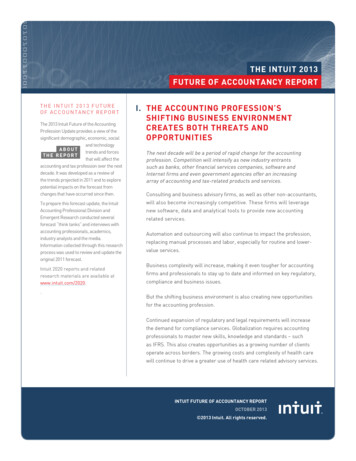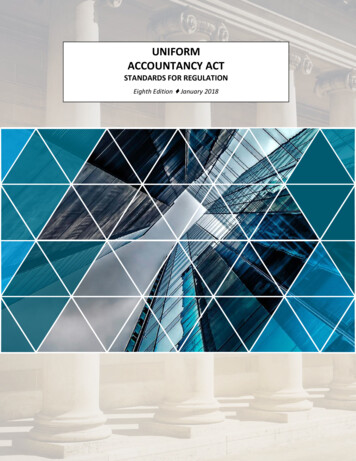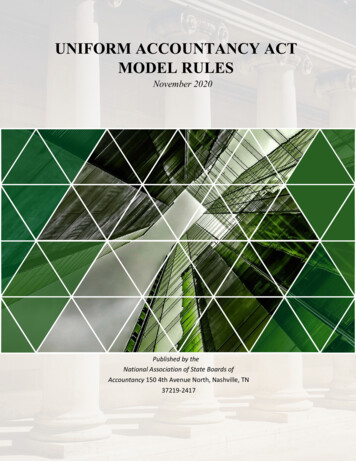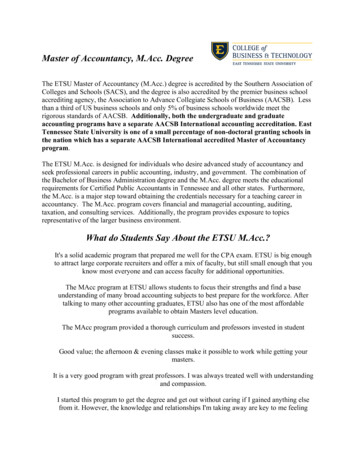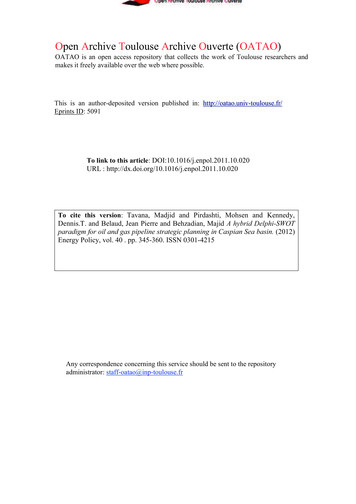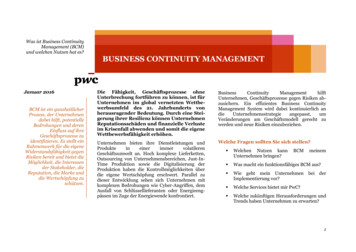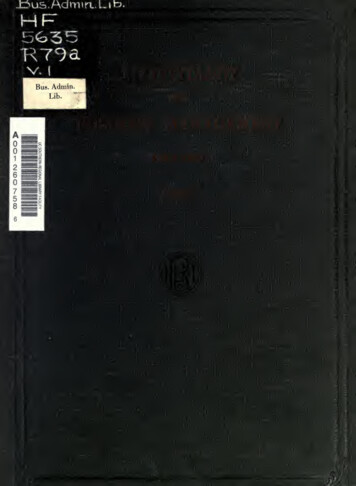
Transcription
& - \JxA om j-iimimeiusi uaikTHE LIBRARYOFTHE UNIVERSITYOF CALIFORNIALOS ANGELEStampedMow
SUGGESTIONS FOR EXAMINING "ACCOUNTANCY AND BUSINESS MANAGEMENT"—PART ONEIt discusses the point of view from which1. The Preface is the authors' "platform."the course of study contained in the text and the accompanying Laboratory Unit was written.2. The "Introduction to Bookkeeping" supplies a topical development of the beginningwork, with short exercises which permit of the teaching of one basic principle or bookkeepingprocedure at a time. See pages 1 to 47.3. Observe the skillful teaching procedure in this beginning work, which is characteristicof the entire course. Note the following steps under the topic "Recording Purchases" onpage1:—the statement of a few facts of common knowledge—reproduction of a purchases and a written-up purchases book.Interpretation of records illustrated— to disclose content of the bookkeeping record.Investigation by means of analysis— observe how the analysis questions on page 3"draw out" information and develop reasoning about the subject being considered.Application and review—exerciseand accompanying analysis.page(a) Information(b) Illustrationin 1(1.bill(c)(d)(e)1,4,Pages 47 to 122 provide instruction and exercise matter to correlate with LaboratoryUnit One, the text matter furnishing the material for class recitations, and Laboratory UnitOne the application of accounting principles in a set of books.If it is desired to begin the study of bookkeeping by this5. Ledger account method.method, pages 47 to 122 the Elementary Accounting Section of the text supply the necessary material. Notice how clearly principles are developed, the frequency with which theyare restated, and the manner in which their application is stressed.6. Paragraphs 26, 34, 61 and 100 are examples of the extreme simplicity and clearness ofthe language of instruction.7. Observe how the division of the text material under topical headings adapts the book4.—to the classmethod—of teaching.Observe particularly the following features:(a) Model Set, pages 14-15.(b) Three short practice sets without vouchers, pages 16-17, 23-24, and 40-42.(c) The simple and effective way of making the pupil understand the equality of debits8.andcredits, pages 26-28.(d) The introduction of the journal at the logical time,and the analogy between it andother books of original entry, pages 33-36.(e) Gradual expansion of the content of cash book entries, pages 37-40.(f) The journalizing exercise and the comparison of classified and journalized sets,page46.The simple yet comprehensive treatment of general ledger accounts, the clear exposition of the principles underlying account classification, and the brief and simple statementof rules.(h) The manner in which rules are developed as the natural outgrowth of basic principles.(i) The "Construction and Interpretation of the Income and Profit and Loss Statement,"pages 100-103; and the corresponding treatment of the Statement of Assets, Liabilities, andCapital, pages 105-108, with the accompanying treatment of accounts by groups.(j) Closing the ledger through the Profit and Loss Summary Account, with separateclosing en PP 'clearing" individual accounts, pages 110 114.(k) The "Recapitulation of Principles," pages 119-122.(1) The Review Exercises, pages 123-127.9. Finally, observe how the subject is stripped of its traditional mass of complicatingdetail and minute discussions of routine practices that are not basic.Note how the text onthe other hand gets immediately to the heart of the subject in every topic presented.(g)THEH. M.ROWE COMPANYSan FranciscoBaltimoreChicagoLibraryGraduate Sch ol of Business Administration.University of CaliforniaT.r\afin rfolqo 9 APol1 "Prtv»n 4t%
Digitized by the Internet Archivein2007 with funding fromMicrosoft ncybusin01roweiala
ACCOUNTANCYANDMANAGEMENTBUSINESSPART ONEBYHARRYM. ROWE, Ph.D.ASSISTED BYHarry M. Rowe,Script by the late C. P.Jr.Zaner and bt E. A. LuppebSOUTHERN BRANCHUNIVERSITY OF CALIFORNIA,LIBRARY, S ANGELES. CALIF. '1922EDITION'I'--\43257THECHICAGOH. M.ROWE COMPANYBALTIMORESAN FRANCISCO
In keeping with the modern trend in business.and in accounting practice, all rulings in books ofentry and ledger accounts in the illustrations inthis book are in black ink. The author recommends the discontinuance of the use of red inkfor bookkeeping purposes in schools in the interestof efficiencyand economy.Copyright 1922BYHarry M. Rowe: ' fWrirutfuluse ofcomunlawmethods,'prc tecte'all tiLe tGpyrightableponent parts ofitsthiswork and prohibitscomposition, illustrations,allInfringers will be punished to the full extentof the law.et .
UUS. Aauun.Library*IPREFACEThe course of study provided in "Accountancy and Business Management,"and in the laboratory practice units which accompany it, is based to some extentupon the author's previous work, "Rowe's Bookkeeping and Accountancy."However, a number of important changes in the teaching plan and in the selectionand arrangement of subject matter make the present course of study substantiallya new and original work.The most important new features are:(a) An Introduction to Bookkeeping at the beginning of the text, in which thefundamental concepts of accepted accounting principles and business operationsare presented in an exceedingly simple and logical manner.The opportunity provided throughout the course of study for teaching by(b)The teaching plan is so elastic,this method is preferred.his personal preference andinstructortoexercisepermitthehowever, as tothe classmethod whenjudgment as to methods(c)A minimumof presentation.use of the reference feature contained in the author's formerworks, with no references to topics other than those under immediate consideration.The separation of the material of the text into consecutive parts to cor(d)the material in the laboratory practice units. Each part of the textwithrespondand the accompanying practice unit can be completed in one semester in the highcommercial and other schools.relativelyshort and can be completed in aboutareunitslaboratoryThe(e)school, or in the equivalent of that time inone-half of a semester, or the equivalent of that time in the business school. Theycontain fewer routine bookkeeping transactions, less detail and repetition in officepractice matter,isand consequently fewer business papers and forms.Emphasisplaced upon principles and the more constructive features of accounting practice.The inclusion of lessons in business management based upon the transac(f)tions in the laboratory units.These lessons arereally brief lectureson businessmanagement and administration which emphasize, as does the text, the ultimateaims of the study of accountancy and the more enduring educational benefits to bederived fromit.Throughout the course the principles and practicesof the subjectand thevarious steps taken in the entire cycle of accounting procedure have been developedas topics for study and recitation on the lesson unit plan to the extent that thesubject permits of thismethodoftreatment.Thepractice exercises following
PREFACEIVeach topic or principle presented in a lesson arc short, and as a rule, can be comClass instruction will be supplemented bypleted easily within one daily period.individual instruction to correct the deficiencies of students as they develop in theworkmay be employedIndividual instructionof the class.This bookto any extent desired.intended for use in cbmmercial courses inall types of schoolsprove to be effective and entirelysatisfactory both in the private school and in the high school because of the recognition which is more and more being given to the greater efficiency of the classisteaching business subjects to beginners.It willmethod of teaching. N Its material and teaching plan are adapted to the requirements of all students taking up the subject for the first time, regardless of whetherit is their purpose to become bookkeepers, to engage in business for themselves,or to pursue advanced courses in accounting and business administrationleading to professional degrees. It emphasizes principles and requires whatthe author believes to be the minimum amount of practice work necessary toprovide the training which the student must secure to make him vocationallyefficient in hisknowledgeof the subject,no matter whether hemaydesire tofollow the occupation of bookkeeper, business manager, or accountant.Unless the principlecourseisto qualifyisconceded that theyoung peopleminimum aimof the bookkeepingto start a business career, there can be nowhatever for teaching utilitarian subjects, and the remarkable growthof commercial courses in public and private schools, which hasbeen the outstanding feature of educational progress in recent years, must bepronounced a serious blunder. In face of the insistent and ever-increasing demandfor education which fits for commerce and industry, and the esteem in which suchpractical education is held by educators and the general public, such a conclusioncannot be maintained successfully.The author's view is that the vocational value of a knowledge of bookkeeping and accounting is merely the immediate object to be served in offering thejustificationand developmentcourse to students of business subjects.Onthe other hand, he contends thatiftheaim of the bookkeeping course were merely to train for bookkeeping positions, thataim could not be realized without at the same time teaching students much of whatSuch informationconstitutes an elementary course in business management.will in any case be absorbed unconsciously to a considerable degree by pupils fromtheir study of business transactions and their records in books of account, whetherthe teacher attempts to emphasize the broader aspects of the subject or not.Sinceboth the educational and vocational interests of students in high schools andprivate schools can be served by a properly constructed course of study, anyattempt to differentiate between their needs in the selection and arrangement oftext material is unnecessary and unwarranted, and would discriminate against
VPREFACEthose whose immediate interestsmaybe of a vocational character.Therefore,while the inclusion of bookkeeping in the curriculum of any school teaching businesssubjects to beginners is not justified unless it does make them vocationally efficient,itschief value lies in the training it imparts in the principlesNoconducting business enterprises.subjectinand methodsthe commercial courseisofsovaluable as the subject of bookkeeping with respect to the opportunities and wealthTheof material if affords for teaching young people how business is transacted.ultimate aim, therefore, of a course of study in this subject should be to supply acomprehensive training in the uses to which accounting records and information areput by business executives in managing and directing commercial and industrialthan to qualify merely for keeping a set of books. Accounting,enterprises, ratheraccordingly, has been coordinated in this text with businessmanagement, andithas been the purpose of the author to emphasize the importance of accountingas an aid to intelligent business administration.Attention is invited to the method which is consistently followed in pre-Reason has been substitutedwhich is to be learned. The openingstatement of a few simple facts in connection with the topic under consideration isfollowed by an illustration that is made the basis of an analytical investigationsenting anewtopic for the student's consideration.for rule in preparing the pupil'smindfor thatwhich discloses the principles to be learned. The results of the analysis are thensummarized in a statement of principles and recapitulation of facts, from whicha brief and simple working rule is deduced. Each rule is essentially a summarization of the instruction on the topic or principle to which it applies.In arranging the first year course in the high school, teachers will have considerable latitude in the use to be made of Part One of the text and of LaboratoryThe Introduction to Bookkeeping, covering the first forty-six pagesrecommended by the author as the first work to be given to allUnit One.of the text, isbeginning students.of the firstIt isstarted and completedmature orestimated thatit willif itby the endrequire approximately six weeksThe worksemester to cover this material.of the first semester.ofIfUnit Onemay then bethe students are im-seems desirable for any reason not to start work on a practice setOne of the text devoted to Elemen-until the second semester, the material in Partbe studied by the class methodduring the remainder of the first semester. This section presents the subjectaccording to the ledger account method and provides an elementary treatmentof trial balances, statements, and the adjustment and closing of accounts.tary Accounting, pages 47 to 127 inclusive,Ifthefirstsemester'sabove, Laboratory UnitworkOnewillIn this case sufficient time willismayconfined to PartOneof the text as suggestedbe started at the beginning of the second semester.be available in the second semester to make an
PREFACEVITwowhich treats of wholesale and partnerTwo, which will be used inthe third semester. In like manner, there will be time in the third semester to makea preliminary study of Part Three, which is devoted to corporation accounting, asa preparation for Laboratory Unit Three. This unit presents corporation andLaboratorygenera] mercantile accounting, and will be used in the fourth semester.Unit Four treats of cost accounting for manufacturers, and provides a fifth semester's work.Of course, if Unit One is used in the first semester, the four units willThus the textrequire four semesters instead of five in which to be completed.and four units provide a two year, or a two and a half year course, according tothe manner in which the material is used.The author also recommends that students
accountancy and businessmanagement partone by harrym.rowe,ph.d. assistedby harrym.rowe,jr. scriptbythelatec.p.zanerandbte.a.luppeb southernbranch
